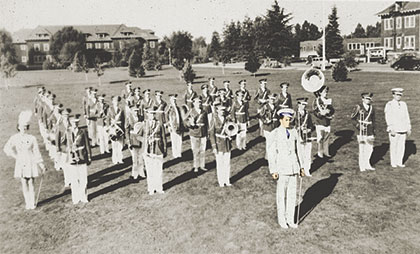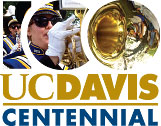
A brief history of UC Davis
The roots of UC Davis reach back to 1905, when the California Legislature approved the establishment of a state agriculture school. Three years later, in October 1908, the University Farm opened at Davis to provide farmers short courses, which were akin to today’s extension classes. The charter mission was to teach students the latest in agricultural methods and technology. The following January, regular classes began with a student body of 18.
Although the school was welcomed immediately—the first Picnic Day, in the spring of 1909, drew more than 2,200 people—the establishment of a new, independent institution of higher learning had not been a foregone conclusion. Many, even those in the farming community, believed that the state’s increased demand could be met with vocational training.

Fortunately, those leaders who understood the great potential of a research-based school prevailed, and set a course from the start toward meeting the needs of California. Historian and former state librarian Kevin Starr characterized the establishment of the University Farm at Davis as an expression of “the Progressive ideal that science and engineering were not merely speculative arenas, but were also instruments by which the world could be improved.”
Research began on the campus as quickly as experiments could start, with an immediate focus on cereal crops and irrigation, along with investigations launched in the creamery and laboratory. The first set of courses covered animal husbandry, crops, horticulture and viticulture, irrigation and veterinary science. Over the next decade and a half, the campus grew from a small school offering practical opportunities for young farmers into, in 1922, a four-year institution prepared to educate California’s future leaders. Graduate instruction began three years later, and 25 years later, in 1950, UC Davis conferred its first Ph.D.—in botany.
Women first attended Davis in 1914, after a women’s dormitory was completed. By then, the school had attracted international attention, already enrolling students from countries as diverse as Australia, Chile, China, Mexico, India, Germany and the Philippine Islands.
Today, UC Davis is one of 10 campuses of the University of California, which was chartered as a land-grant college in 1868 and now constitutes the nation’s leading public higher education system. Located close to the state capital, UC Davis has more than 31,400 students, an annual research budget that exceeds $500 million, a comprehensive health system and 13 specialized research centers. It hews closely to its land-grant mission of engaging in teaching, research and service for the greater public good.
The university offers interdisciplinary graduate study and more than 100 undergraduate majors in four colleges—Agricultural and Environmental Sciences, Biological Sciences, Engineering and Letters and Science—and advanced degrees from five professional schools—Education, Law, Management, Medicine and Veterinary Medicine. A sixth professional school, the Betty Irene Moore School of Nursing, is proposed. Graduate Studies offers advanced study and research opportunities in nearly 90 programs. And UC Davis is one of only 62 universities admitted to the prestigious Association of American Universities. The Davis campus is physically the largest of the 10 UC campuses, with 5,300 acres. Among the 10 UC campuses, Davis is first in non-federal research expenditures and third in enrollment.
Today, true to its land-grant mission, UC Davis touches everything that matters to us as people.
For 100 years, it has prepared and inspired students and discovered solutions to some of society’s most pressing problems. As we look to the future, UC Davis is addressing those things that matter most to California in order to transform the world.